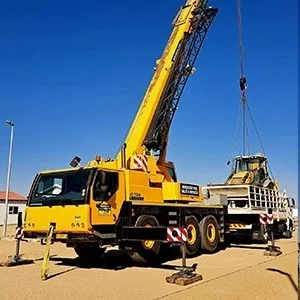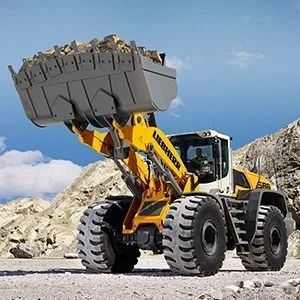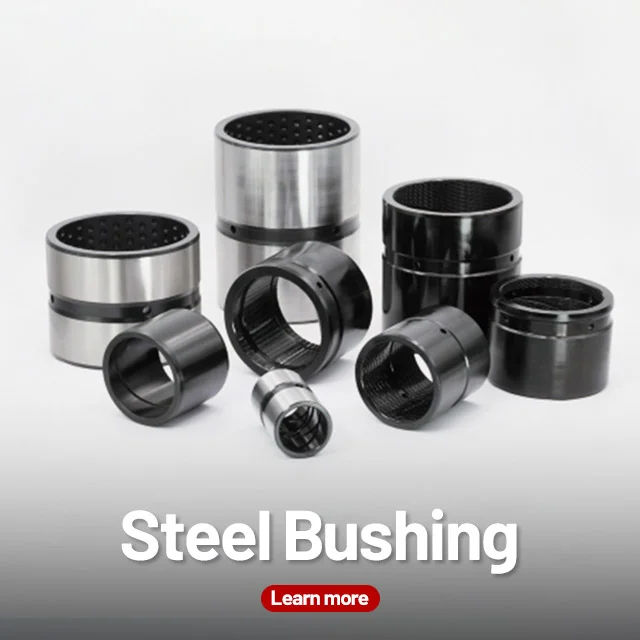Self-lubricating bushings use specialized polymer materials that eliminate the need for external lubrication, providing low friction and wear resistance for various mechanical applications. Their design ensures excellent performance under dry operating conditions, extending equipment lifespan.

Metal Polymer Self Lubricating Bushing
The Metal Polymer Self Lubricating bushing is a high-performance, self-lubricating bearing designed for a wide range of industrial and automotive applications. Made from a composite material with a low-friction PTFE (polytetrafluoroethylene) layer, it delivers excellent wear resistance and requires no additional lubrication, making it ideal for reducing maintenance costs and improving efficiency in harsh working environments.
Table Of Contents For This Page
To make sure you can find the information you want quickly,
we have prepared this content directory that will jump to the corresponding location when you click on it.
Bushing Material
Choosing a bushing’s material is primarily selecting three layers – the metal base, intermediate layer, and the surface layer or self-lubricating layer on bushings.
Here are some of the common equivalents or aliases : SF-1 bushings、DU Bushing、PTFE Lined Bushings、Composite Bushings、Plain Bearings etc.
The MW-1 bushing is an oil-free bearing used in many mechanical applications, especially where lubrication is difficult or oil is not allowed. This bearing consists of three layers typically constructed from the following materials.
1. Surface Sliding Layer: Generally composed of a mix of polytetrafluoroethylene (PTFE) and lead PTFE provides a very low friction coefficient with good wear resistance, while the lead increases the load capacity and the ability to form a lubricating film.
2. Intermediate Support Layer: Made of bronze or steel backing, this layer offers mechanical strength and thermal conductivity characteristics so that the bearing can handle higher loads and dissipate heat better.
3. Bonding Layer: Between the PTFE mix and the support layer, this layer often uses some kind of adhesive.
The design of the Composite bushing makes it ideal for high-load, high-heat and situations where it drives the friction down significantly.
Materials Structure And Thickness(Metallurgied Structuer)
- PTFE layer:0.01-0.03 mm
- Porous bronze:0.2 -0.3 mm
- Steel backing: 0.7 .2.3 mm
- Electroplating layer: Tin-plating about 0.005 mm, or copper-plating about 0.008 mm


Material Combination

Copper black PTFE

Tin plated black PTFE

Tin Plating red

Copper tinned white

Bronze base black

Bronze base with notched

Stainless steel black

Backroll
| Type | Photo | Lining | Sinter Bronze | Backing | Application Characteristic |
| MW-1W(P4) | PTFE+PI+MoS₂+aramid fibre+Other | CuSn8Zn3 | SPCC or DC01 | General,lead free | |
| MW-1T | PTFE+fibre+Other | CuSn8Zn3 | SPCC or DC01 | For geer pump | |
| MW-1P | PTFE+Bronze+Other | CuSn8Zn3 | SPCC or DC01 | For liner movement | |
| MW-1W | PTFE+fibre+Other | CuSn8Zn3 | SPCC or DCO1 | lead free | |
| MW-1B | PTFE+fibre+Other | CuSn8Zn3 | CuSn6.5P0.1 | Acid-resistant and alkali-resistant, better reliability | |
| MW-1D | PTFE+fibre+Other | CuSn8Zn3 | SPCC or DCO1 | For Hydraulic | |
| MW-1S | PTFE+fibre+Other | CuSn8Zn3 | 304 or 316 | Better acid-resistant and alkali-resistant | |
| MW-1SS | PTFE+Other | No | 304 or 316 | Best acid-resistant and alkali-resistant,light load |
Bushing Size




Bushing Shape
The different bushing shapes allow bushings to be widely used in various mechanical structure parts, such as the moving parts inside cars or the connecting parts on industrial machinery or other situations where there’s friction and wear that needs to be beaten down.

Cylindrical

Flanged

Thrust Washers

Wear Plates

Wear Plates

Bearing Bush
Key Features of MW-1 Bushing
- Self-Lubricating Works without adding additional oil because of its material’s composition. The PTFE layer provides lube for the life of the bushing.
- Maintenance-Free: Can be used and runs well without continually oiling these things.
- High Load: Works with high dynamic and static loads for demanding applications.
- Wide Temperature Range: From -195°C to +280°C.
- Chemical and Corrosion: Resistant The bushings are resistant to chemical corrosion and have a long service life in different environmental conditions.
- Low Noise and Vibration Reduces the noise and and the levels of vibration coming out, creating a quieter operating machine.
- The machines can be made more compact because of the thin wall and light weight of the bushes.
- Electroplating can be easily applied to prevent corrosion, and is now widely used in various sliding parts.

Bushing Applications
Powder metallurgy bushings are widely used across various industries, suitable for different loads and environmental conditions:
1. Automotive Industry
- Component Use: Engine, transmission, suspension, and steering system bearings.
2. Home Appliances
- Component Use: Rotating bearings in washing machines, fans, air conditioners, and other household devices.
3. Industrial Equipment
- Component Use: Key bearings and support components in industrial pumps, compressors, and hydraulic systems.
4. Power Tools
- Component Use: Rotating components in drills, sanders, and saws.
5. Office Equipment
- Component Use: Sliding components and bearings in printers, copiers, and scanners.
6. Agricultural Machinery
- Component Use: Rotating and sliding parts in seeders, harvesters, and tractors.

Automobile

Truck

Tractor

Dump Truck

Excavator

Combine Harvester

Crane

Bulldozer

Loader

Graders
Custom Services and Solutions
Customization & Support Services
- Multiple Customization Options: Tailor materials, dimensions, and designs to meet specific customer needs, ensuring optimal compatibility.
- Professional Technical Support: Provides selection advice, installation guidance, and on-site technical consultations to help customers optimize performance.
- Fast Delivery: Robust supply chain and logistics services ensure timely delivery, reducing the risk of customer downtime.
Free consultation
Communicate with us to clarify the requirements
Free design
Customize your product according to your needs
Sample making
Confirm the drawings and arrange for sampling
Sample confirmation
Customer confirms sample and arranges production
Finished inspection
Inspect the finished product and arrange for shipment
FaQ
Are you a factory?
Of course, we are a manufacturer that can complete the entire production line from raw materials to finished bushing products.
What bushings do you production?
We mainly produce various self-lubricating bushings. Please refer to our product solutions or contact us for details
What is a bushing?
What is the general process for manufacturing bushings?
Bushing manufacturing involves several key steps:
Material Selection: Choosing the appropriate material such as bronze, rubber, or plastic, depending on the application.
Forming: Techniques like casting, pressing, or extrusion are used to shape the raw material into a bushing.
Heat Treatment: For metal bushings, heat treatment is applied to increase strength and wear resistance.
Finishing: This step involves precision machining to achieve the required dimensional tolerances and surface finish.
Surface Treatment: A coating may be applied for corrosion resistance or lubrication purposes, such as zinc plating or Teflon coating.
What materials are commonly used in bushing production?
Common materials used in bushings include:
Bronze: Known for its durability and low friction, often used in heavy-duty applications.
Rubber: Used for vibration dampening in automotive and machinery applications.
Nylon/Polymer (like PTFE): Provides self-lubrication and is ideal for low-load, low-friction environments.
Steel: Used for high-load applications, often combined with a softer material like bronze or plastic as the lining.
How are bushing dimensions and tolerances maintained during production?
What surface treatments are used for bushings?
Bushings often undergo surface treatments to enhance their properties:
Zinc or nickel plating: Protects the metal surface from corrosion.
Teflon (PTFE) coatings: Provide low friction and self-lubricating properties.
Phosphating or black oxide coating: Improve wear resistance and reduce the potential for galling (severe adhesion between surfaces in motion).
What are the challenges in bushing production?
Key challenges include:
Maintaining precision: Ensuring dimensional accuracy across large production runs can be difficult, especially for complex shapes.
Material selection: Using the wrong material could result in failure under stress or environmental conditions.
Surface finish quality: Achieving smooth surface finishes is crucial to reducing friction and wear.
Can bushings be custom-made?
What environmental factors are considered in bushing production?
Manufacturers consider several environmental aspects:
Material sustainability: Using eco-friendly or recyclable materials.
Waste management: Minimizing production waste and properly handling hazardous materials.
Energy consumption: Optimizing energy use in production processes to reduce carbon footprint.
What is the purpose of a bushing?
How can I tell when a bushing needs to be replaced?
Signs that a bushing may need replacement include:
Cracks, splits, or visible damage.
Increased noise, such as squeaking or grinding.
Excessive play or movement in the component where the bushing is installed.
Vibration or instability in the machinery or equipment.
How do I maintain bushings?
What is the difference between a bushing and a bearing?
How long do bushings last?
More Related Bushing products
Contact Us for More Information
We not only provide high-quality self-lubricating bushings but also offer comprehensive technical support and after-sales service to ensure your equipment always operates at peak performance. If you have any questions or need a quote, please feel free to contact us at any time.
Tel/Whatsapp:+86 136 4583 4002
Email:ivan@mybushing.com





